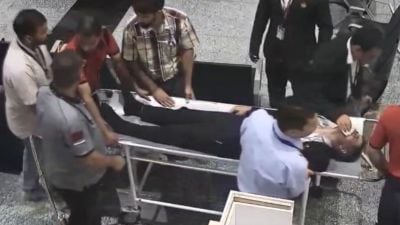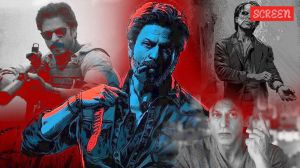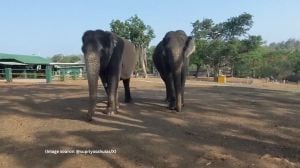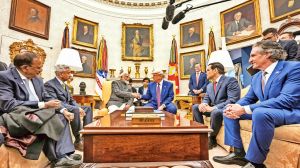Click here to join Express Pune WhatsApp channel and get a curated list of our stories
An officer and a gentleman: The man who eliminated Paan Singh Tomar was both and more, his memoirs reveal
Vijay Raman, was serving as assistant inspector general (AIG) Special Branch, Bhopal and was appointed IG, BSF in Kashmir in 2003.
 Vijay Raman and his upcoming memoir, 'Did I really do all this?’ will be launched in New Delhi.” This “Memoirs of a gentleman cop who dared to be different’, published by Rupa Publications. (Photo: book cover from rupapublications.co.in)
Vijay Raman and his upcoming memoir, 'Did I really do all this?’ will be launched in New Delhi.” This “Memoirs of a gentleman cop who dared to be different’, published by Rupa Publications. (Photo: book cover from rupapublications.co.in)Vijay Raman, a retired high-profile IPS officer belonging to the 1975 batch of Indian Police Service (IPS) officers, was the Superintendent of Police in Madhya Pradesh’s Bhind district when he led the 14-hour encounter against athlete-turned-dacoit Paan Singh Tomar on October 1, 1981.
His encounter against Tomar, wasn’t the only time he was at the forefront of crucial events shaping this country. Raman was part of multiple anti-terrorist and anti-Naxal operations and worked with different establishments including MP police, Central Reserve Police Force (CRPF), Border Security Force (BSF) and Railway Police.
 Vijay Raman in the centre along with young cadets. (File photo)
Vijay Raman in the centre along with young cadets. (File photo)
When the world’s worst industrial disaster—the Bhopal Gas Tragedy—occurred, Raman was serving as assistant inspector general (AIG) Special Branch, Bhopal. Raman was appointed IG, BSF in Kashmir in 2003 with the secret mandate to nab Ghazi Baba, mastermind of the 2001 attack on the Indian Parliament.
From 1985 till 1995, he worked with four Indian PMs as a member of their security and was a close witness to the working of the Government of India and the Prime Ministers Office.
Even after he retired from service in February 2011 and settled down in Pune, he was selected as one of the three members of the Special Investigating Team (SIT) stationed in Bhopal to investigate the Vyapam scam in connection with alleged malpractices in the professional entrance exam.
 Vijay Raman with his pet ‘Sheru’.
Vijay Raman with his pet ‘Sheru’.
It was at age 72 that he passed away in Pune after he was detected with cancer a year ago. On September 20, a book titled, ‘Did I really do all this?’ will be launched in New Delhi.” This “Memoirs of a gentleman cop who dared to be different’, published by Rupa Publications is a befitting tribute to the highly-decorated officer who has to his credit a most sterling and eventful career.
His wife Veena Raman says, “He began writing the book two years ago. For him, it was his duty towards the nation, so he never thought he was doing something extraordinary. But I could see how extraordinary he was.”
“It was only towards the end of his life, as he grew weaker, that we worked fast and furiously to get everything down on paper. When the final pages of this book appeared, he said to me, with some surprise and wonder, ‘Veena, did I really do all this?” she writes in the introduction of the book. That’s how the book got its title, says Veena.
 Raman receiving awards for his meritorious service in the Indian Police Services. (File photo)
Raman receiving awards for his meritorious service in the Indian Police Services. (File photo)
Paan Singh Tomar
Raman in his memoir, dedicated a chapter in great detail about his encounter with Paan Singh Tomar with official documents showing the layout of the village and scene of the encounter, pictures of officers being congratulated by authorities after its success. Raman describes how controlled and careful firing did not allow dacoits to gauge their positions was key to the success of the operation.
Describing his thoughts after the operation and due to a sudden surge of congratulatory calls he was receiving, Raman writes, “Paan Singh had served in the Indian Army. He had won athletics medals for India. When he returned home to his village, the disparities and inequities of Indian society gave him no choice but to turn to dacoity. The media focused on these, which gave rise to huge sympathy for Tomar and contempt for the law-keepers who had gunned him and his gang down.
There was no mention of the fact that, in the course of our duty, and at great risk to our own lives, we had removed a dangerous criminal and his gang from the face of this earth. However, people of Chambal and its surroundings, who had lived in terror of the gang’s burglaries and abductions, were deeply grateful for the capture.”
Bhopal Gas Tragedy
After the Bhopal Gas Tragedy, as Raman went around the city, trying to figure out what had happened, he reached platform 1 of the railway station only to see the place piled up with lifeless bodies. “They were lying helter-skelter, as they had fallen, and I could see many corpses with intestines spilling out of the anal area. I did not allow the dreadful sight to affect me—it was my duty to find someone here who could tell me what had happened. I walked around to try and locate a person who was still alive, but could not,” he writes.
He recalls, “Inhaling the gas created a physical urge to rush desperately towards water. As people ran, they panted, struggled for breath, and inhaled even more than they would have if they had not run! That image of people running for their lives, and the very act of running taking them closer to death is one that will never leave me. There were people who ran 40 km that night. They too, died. We know this because bodies were found in Raisen, 40 km from Bhopal”.
On 26 January 1985, receiving the President’s Police Medal for gallantry for liquidating dacoit Paan Singh Tomar and his gang, he soon after entered the next phase of his career as assistant director (AD) of a new unit called SPG, the Prime Minister’s Special Protection Group.
Protecting four PMs
In this chapter, while he hailed Rajiv Gandhi as the most charismatic, popular and disciplined PM, he was full of praise for Chandrashekhar’s sense of humour and pragmatism. Narsimha Rao made a deep impression on him for his knowledge and education, while VP Singh is referred to as the PM who was suspicious of everyone and everything.
Click here to join Express Pune WhatsApp channel and get a curated list of our stories












